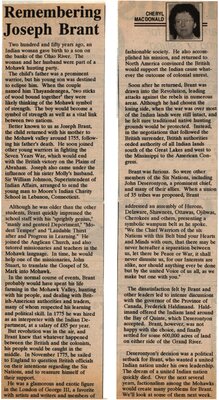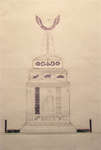"Remembering Joseph Brant"
- Full Text
- Remembering Joseph Brant
Two hundred and fifty years ago, an Indian woman gave birth to a son on the banks of the Ohio River. The woman and her husband were part of a Mohawk hunting party.
The child's father was a prominent warrior, but his young son was destined to eclipse him. When the couple named him Thayandenegea, "two sticks of wood bound together" they were likely thinking of the Mohawk symbol of strength. The boy would become a symbol of strength as well as a vital link between two nations.
Better known to us as Joseph Brant, the child returned with his mother to the Mohawk valley around 1755, following his father's death. He soon joined other young warriors in fighting the Seven Years War, which would end with the British victory on the Plains of Abraham. Joseph also came under the influence of his sister Molly's husband. Sir William Johnson, Superintendent of Indian Affairs, arranged to send the young man to Moore's Indian Charity School in Lebanon, Connecticut.
Although be was older than the other students, Brant quickly impressed the school staff with his "sprightly genius," "manly and genteel Deportment," "Modest Temper" and "Laudable Thirst after and Progress in Learning." He joined the Anglican Church, and also tutored missionaries and teachers in the Mohawk language. In time, be would help one of the missionaries, John Stuart, to translate the Gospel of St. Mark into Mohawk.
In the normal course of events, Brant probably would have spent his life fanning in the Mohawk Valley, hunting with his people, and dealing with British-American authorities and traders, many of whom respected his learning and political skill. In 1775 be was hired as an interpreter with the Indian Department, at a salary of £85 per year.
But revolution was in the air, and Brant knew that whatever happened between the British and the colonists, his people would be caught in the middle. In November 1775, be sailed to England to question British officials on their intentions regarding the Six Nations, and to reassure himself of their support.
He was a glamorous and exotic figure in the London of George III, a favorite with artists and writers and members of fashionable society. He also accomplished his mission, and returned to North America convinced the British would support the Indian cause whatever the outcome of colonial unrest.
Soon after he returned, Brant was drawn into the Revolution, leading attacks against the rebels in numerous areas. Although be had chosen the losing side, when the war was over most of the Indian lands were still intact, and be felt sure traditional name bunting grounds would be protected. Instead, in the negotiations that followed the British surrender, British authorities ceded authority of all Indian lands south of the Great Lakes and west to the Mississippi to the American Congress.
Brant was furious. So were other members of the Six Nations, including John Deserontyon, a prominent chief, and many of their allies. When a union of 35 tribes was proposed, Brant addressed an assembly of Hurons, Delaware, Shawnees, Ottawas, Ojibwas, Cherokees and others, presenting a symbolic wampum belt as be spoke. "We the Chief Warriors of the six Nations with this Belt bind your Hearts and Minds with ours, that there may be never hereafter a separation between us, let there be Peace or War, it shall never disunite us, for our Interests are alike, nor should anything ever be done but by the united Voice of us all, as we make but one with you.
The dissatisfaction felt by Brant and other leaders led to intense discussions with the governor of the Province of Canada, Frederick Haldimand. Haldimand offered the Indians land around the Bay of Quinte, which Deserontyon accepted. Brant, however, was not happy with the choice, and finally settled for some 600,000 acres of land on either side of the Grand River.
Deserontyon's decision was a political setback for Brant, who wanted a united Indian nation under his own leadership. Tbe dream of a united Indian nation quietly died. Over the next several years, factionalism among the Mohawks would create many problems for Brant. We'll look at some of them next week.
- Mystery Question
- When was this article published?[Please answer by clicking on the Comments tab]
- Creator
- Macdonald, Cheryl, Author
- Media Type
- Newspaper
- Publication
- Item Types
- Articles
- Clippings
- Description
- "Two hundred and fifty years ago, an Indian woman gave birth to a son on the banks of the Ohio River. The woman and her husband were part of a Mohawk hunting party."
- Subject(s)
- Personal Name(s)
- Johnson, William ; Brant, Joseph ; Stuart, John ; Deserontyon, John ; Haldimand, Frederick.
- Local identifier
- SNPL003495v00d
- Collection
- Scrapbook 4
- Language of Item
- English
- Creative Commons licence
 [more details]
[more details]- Copyright Statement
- Public domain: Copyright has expired according to Canadian law. No restrictions on use.
- Copyright Holder
- Simcoe Times-Reformer
- Contact
- Six Nations Public LibraryEmail:info@snpl.ca
Website:
Agency street/mail address:1679 Chiefswood Rd
PO Box 149
Ohsweken, ON N0A 1M0
519-445-2954



